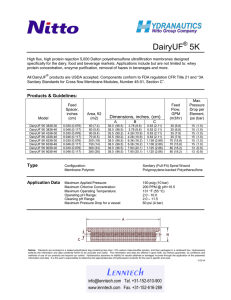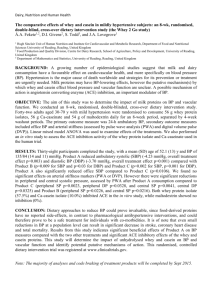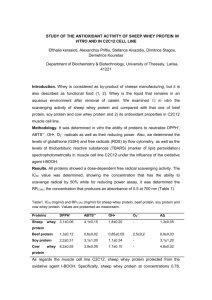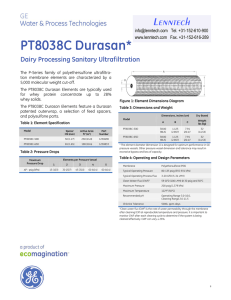Electromat * Electrodialysis (ED) and Bipolar Electrodialysis (BPED)
advertisement
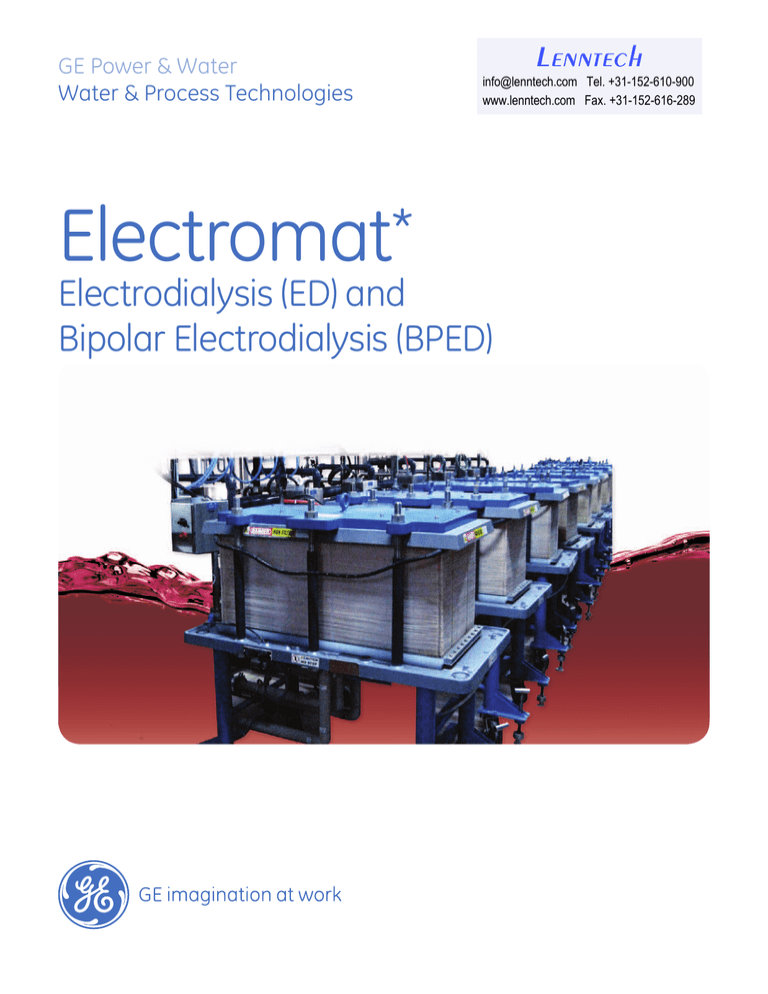
GE Power & Water Water & Process Technologies * Electromat Lenntech info@lenntech.com Tel. +31-152-610-900 www.lenntech.com Fax. +31-152-616-289 Electrodialysis (ED) and Bipolar Electrodialysis (BPED) Rely on GE’s technology and experience Electrodialysis Timeline: GE focuses on improving our customers’ processes and enhancing their products with our Electromat ED and BPED Technologies. We have 1948 Ionics develops ion exchange membranes experience with whey demineralization, glycerine desalting, fruit juice deacidification, glycol recovery, and numerous other applications. 1950 ED technology is developed Our ED advantage • Enhances product value, reduces processing costs, and derives value from waste streams • Removes only ionized species, leaving valuable constituents behind • Reduces chemical consumption and salt effluent 1959 Ionics, working with Wyeth & Foremost, develops ED process for whey demineralization • Processes can be tuned to meet any product set point, eliminating wasted energy, time, and product 1961 First production system for whey ED • Skid mounted and automated to operate in continuous or batch mode for simple, reliable operation • Modular system designs allow for easy expansion 1980 Ionics introduces continuous ED process for whey demineralization The GE Advantage Reliable Speed • Quick delivery • World-class designs • Configurable options • Customized • Experience that systems to meet product creates quick specifications solutions • Worldwide installations • 50+ years of experience One Source • Vertical technology system integration • Trusted performance • Technical expertise • Core membrane design and manufacturing capability 1986 Ionics installs ED system at a gas field in Colorado to reclaim glycol 1999 Ionics ED system installed in Italy for lactulose demineralization Feed Process (Dilute) Stream Demineralized Product Ion transfer by DC voltage Brine Makeup Water (typically RO or softened city water) Brine Blowdown (concentrate) Stream with salt transferred from feed Makeup Water Acid H+ X- Dilute Solution Salt Solution M+ OHMakeup Water Caustic What is ED? ED is an electrochemical separation process where ions are transferred through selective ion exchange membranes from one solution to another by means of a DC voltage. 2005 GE purchases Ionics and introduces Electromat Nx4 for large volume whey demineralization What is BPED? BPED is an ion exchange membrane process that uses a bipolar membrane to split water into H+ and OH-, generating acid and caustic streams. This process adjusts a solution’s pH without adding bases or acids. 2008 GE ED system installed in India for continuous 90% demineralization of acid casein whey 2009 GE installed BPED system at a grape juice producer to adjust the pH of grape juice 2010 GE ED system used for glycerine desalting A success story Whey Demineralization Rich in milk sugar (lactose) and whey proteins, reduced minerals whey is used in infant formula, ice cream, energy drinks, dry mixes and other food products. Since reduced minerals whey is becoming a more common ingredient in food, there is a growing need for efficient and effective deminerlization processes. GE’s ED Systems offer continuous demineralization from 25% to 90%+ without blending. ED provides stable pH and less denaturing of protein with no regeneration chemical effluent. Challenge: A whey producer in Europe needed an efficient method to further process whey into profitable products. Solution: GE installed a continuous ED system to expand whey demineralization capacity and reduce production costs. Results: The company is now the largest producer of demineralized whey, operating many of GE’s ED systems in multiple factories. A success story Glycerine Desalting One of the by-products of biodiesel production is crude glycerine. Once purified, glycerine can be sold for personal care, food or pharmaceutical products or can be used in manufacturing other chemicals. GE’s ED Systems provide an efficient solution to purify glycerine. After pre-treatment to remove free fatty acids and other organics, GE’s ED Systems remove more than 98% of salt in the glycerine. If needed, additional polishing after ED can achieve more than 99% salt removal. GE’s ED technology provides a competitive solution to convert a waste stream into a valuable product. Compared to vacuum distillation, ED offers many advantages, including a simplified process; easy expandability; lower overall processing costs; and low energy usage. Challenge: A specialty chemical manufacturer in Michigan, USA had an ED system that did not effectively desalt glycerine to its expected capacity. Solution: After determining that the existing system was undersized and not properly designed to process the glycerine, GE designed and replaced the system with an Electromat ED System. Results: The new system successfully removes more than 98% of the salt from the crude glycerine. A success story Wine and Grape Juice Wine and grape juice contain tartrates, which can precipitate in the finished product if not removed. ED offers an energy efficient method to remove a portion of the tartrates to stabilize the finished product. Additionally, some producers need to lower pH. GE’s BPED system lowers the pH and removes potassium from the juice and wine. GE’s ED and BPED systems advantages include: no impact on wine characteristics (sugar content, alcohol level, taste), no chemical additives or temperature changes, lower energy consumption and faster processing compared to cold stabilization. Challenge: A grape juice producer in California, USA needed to meet environmental discharge limits for tartrate stabilization. Solution: GE installed a combined ED and BPED system to lower the effluent levels, while adjusting the pH. Results: The producer meets discharge limits and consistently achieves tartrate stabilization and their target grape juice pH. Fruit Juices BPED can also create low acid versions of orange, apple and cranberry juice. GE’s BPED system adjusts pH naturally without the addition of chemicals, providing a reliable, accurate pH for consistent product quality and taste. These juices can be marketed as “naturally sweetened juice.” A success story Glycol and Amine Glycol, used as a dehydrator for natural gas extraction, picks up mineral hardness that scales reboilers. Similarly, amine solutions are employed to remove H2S, CO2 and other impurities during gas treating — a process referred to as sweetening in refineries and petrochemical plants. ED reduces organic acids and other heat stable salts that build up in the amine solutions, thus improving their ability to extract acid gas. ED is an economic and environmentally-friendly alternative for removing ionic impurities from both glycol and amine solutions. Challenge: An oil company operating a remote gas field in western Colorado, USA needed to find a method to purify their glycol solutions onsite. Solution: GE installed an ED system operating in continuous mode to maintain hardness at low levels, allowing glycol to be concentrated and reused without scaling. Results: Scaling in the reboiler was virtually eliminated, allowing the plant to operate more efficiently, with lower glycol consumption. Other applications • Purification of lactose, lactulose, and galactose • Demineralization of nonfat milk • Demineralization of corn syrup/sugar solutions • Production of organic acids from salts • Converting salt into dilute acid and base • Purification of protein solutions Pilot testing GE can perform lab-scale ED pilot tests on customer-supplied feed samples. These tests help define operating parameters and provide customer product samples for evaluation. GE can also arrange larger-scale ED pilot tests with one or more full-size ED stacks. Lenntech info@lenntech.com Tel. +31-152-610-900 www.lenntech.com Fax. +31-152-616-289 * Trademark of General Electric Company; may be registered in one or more countries. ©2010, General Electric Company. All rights reserved. GEA18114 (04/2010)
